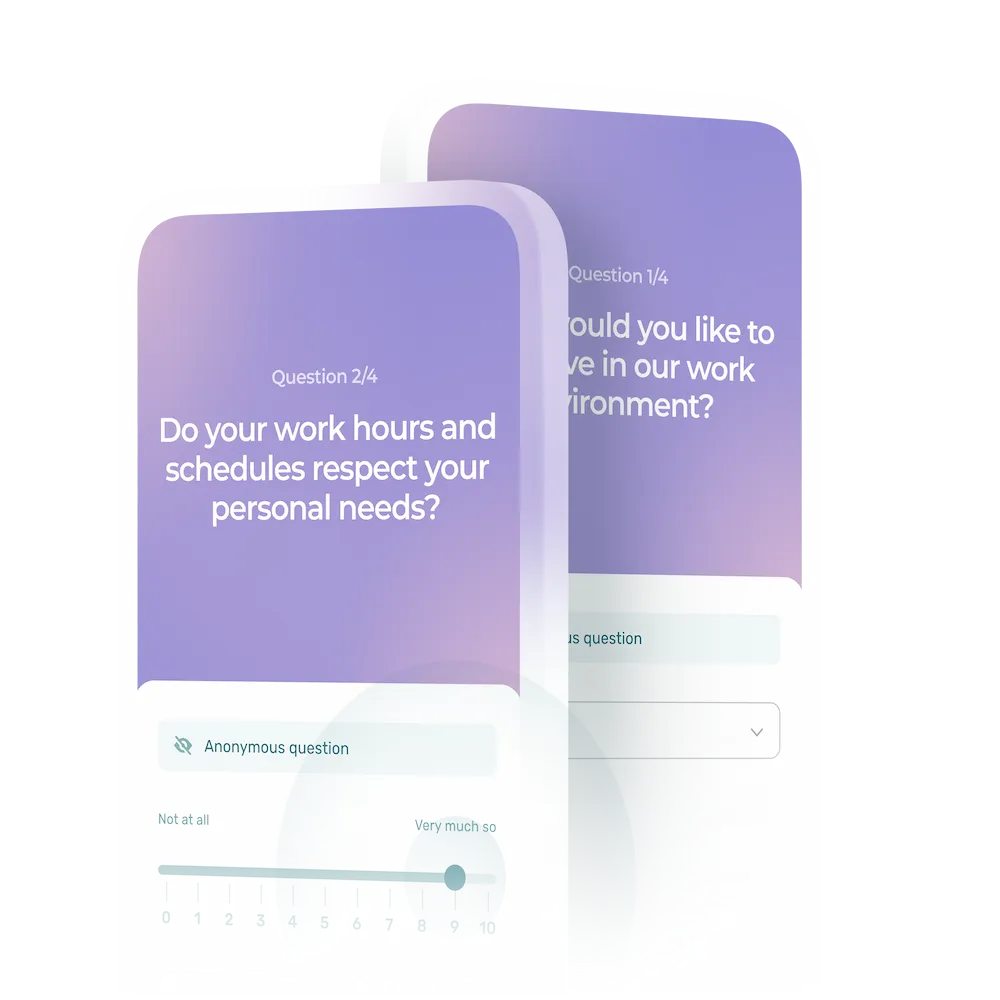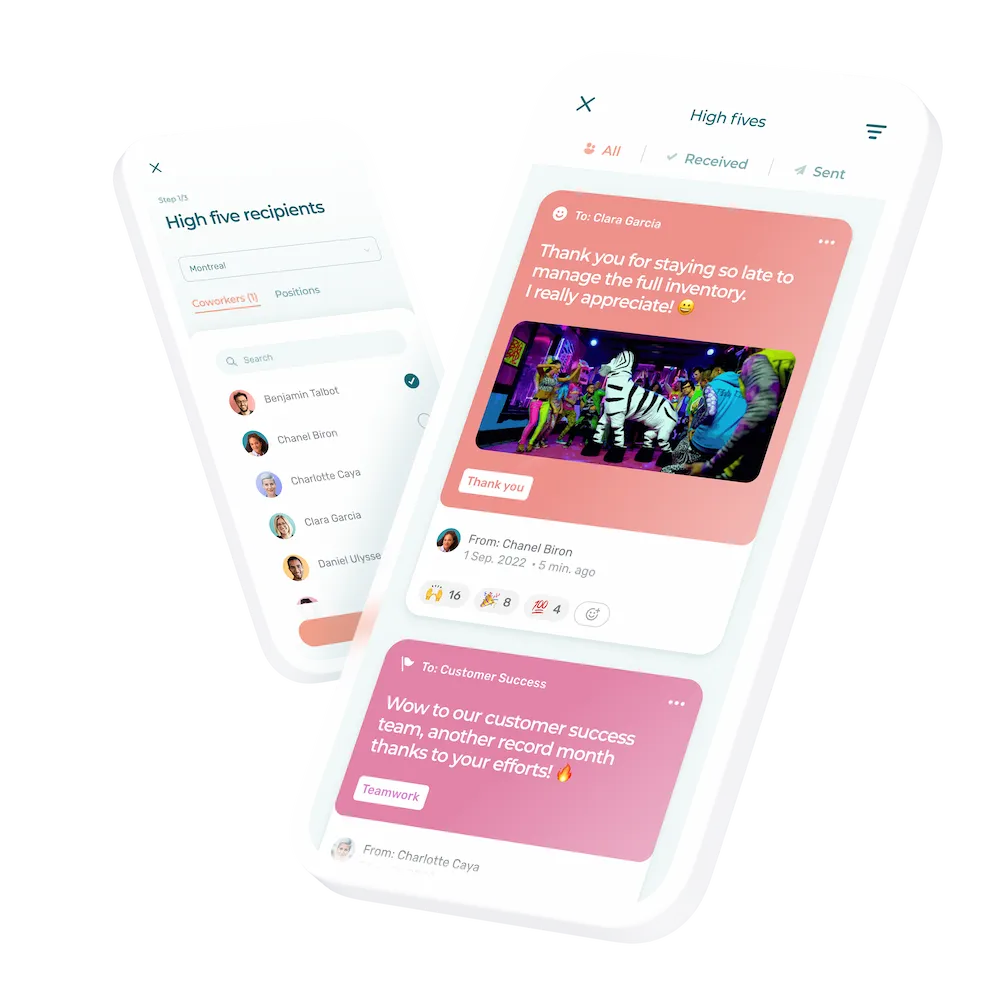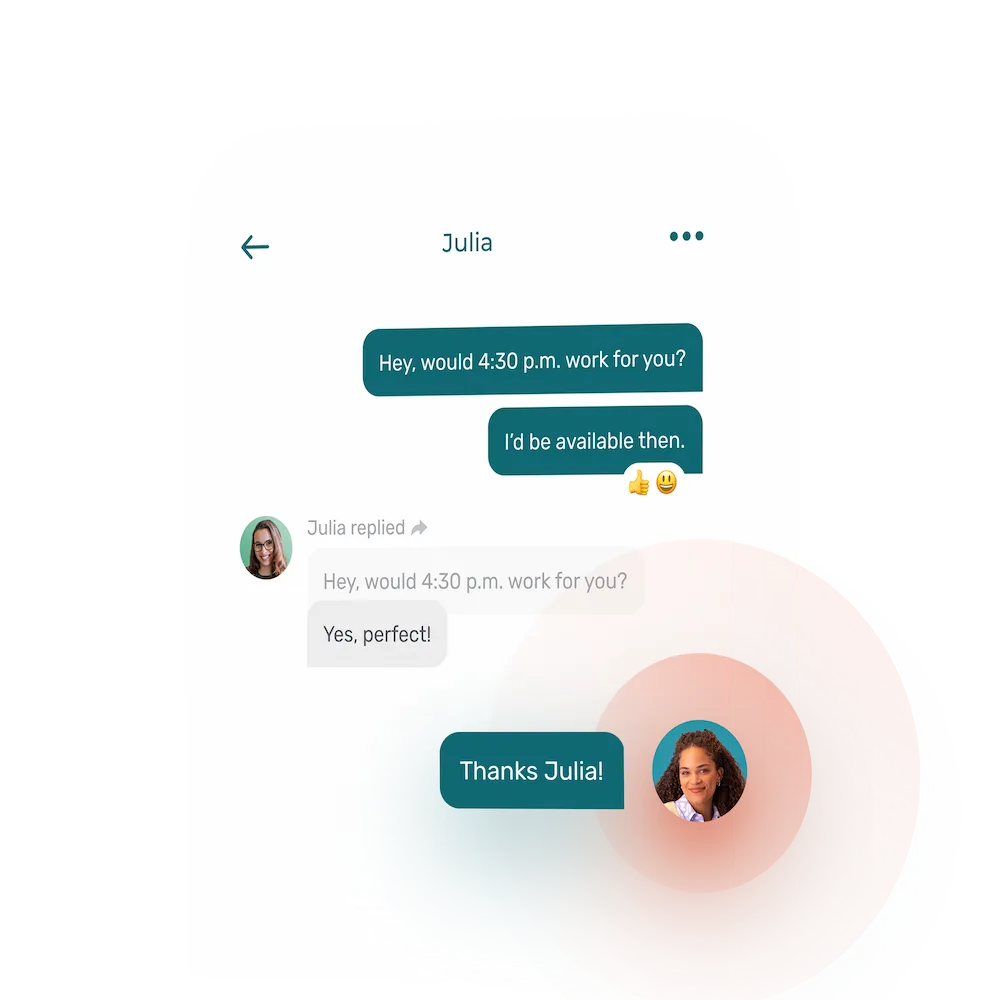Why is workplace mental health so important? Employers that support the mental well being of employees report lower absenteeism and turnover rates, but also more motivated and productive teams – all of which lead to a healthier bottom line.
Discover key stats on employee mental health and practical tips for promoting positive mental health in your company.
Key Takeaways
- Decent work conditions and a sense of purpose are good for workplace mental health.
- Poor work environments with discrimination and inequality, excessive workloads, little job control, and job insecurity are some of the risk factors that can lead to poor mental health.
- Failing to support mental health at work can lead to low employee engagement and productivity, high absenteeism, and turnover, all of which significantly impact the bottom line.
- Health and safety laws require businesses to provide employees with a healthy and safe woriplace, not only to protect their physical health but also their mental health.
- Businesses should consider implementing health and wellness programs for addressing mental health issues and countering the risk factors that can negatively affect mental health.
Key Stats on Employee Mental Health in the Workplace
The following stats illustrate to what extent workplace mental health affects both employees and employers.
- 81% of workers report that workplace stress affects their mental health.
- 92% of workers experience mental health problems that impact their work.
- 80% of workers say that employer support for mental health is an important consideration when evaluating job opportunities.
- 55% of workers say their employer thinks their workplace environment is a lot mentally healthier than it is.
- 43% of workers worry that if they told their employer about a mental health condition, it would negatively impact them in the workplace.
- Globally, an estimated 12 billion working days are lost every year to depression and anxiety, costing US$ 1 trillion per year in lost productivity.
Common Risks to Mental Health at Work
Workplace risks to mental health, also called psychosocial risks, can be related to several things:
- Under-use of skills or being under-skilled for work
- Excessive workloads or work pace, understaffing
- Long, unsocial, or inflexible hours
- Lack of control over job design or workload
- Unsafe or poor physical working conditions
- Organizational culture that enables negative behaviors
- Limited support from colleagues or authoritarian supervision
- Violence, harassment, or bullying
- Discrimination and exclusion
- Unclear job role
- Under- or over-promotion
- Job insecurity, inadequate pay, or poor investment in career development
- Conflicting home/work demands
6 Benefits of Prioritizing Mental Health in the Workplace
1. Improved Employee Retention
By prioritizing the well-being of your employees and creating a safe workplace that is conducive to good mental health, they will be more inclined to stay in your employment.
- Nearly 50% of workers are willing to quit to improve their work/life balance.
- Replacing an employee can cost one-half to two times the employee’s annual salary, depending on their position.
2. Better Team Productivity and Performance
Mental health issues such as stress, anxiety, and depression can negatively affect an individual’s ability to concentrate, make decisions, and perform tasks effectively. By addressing mental health concerns, employers can help maintain high levels of productivity and job performance among their workforce.
3. Less Employee Absenteeism
Mental health problems often lead to absenteeism as employees may find it difficult to cope with job stressors and need time off to address their issues. By promoting mental health awareness and providing support, employers can reduce absenteeism rates and ensure continuity in operations.
See 8 causes of workplace absenteeism and how to resolve them.
Make tracking employee time and attendance easy.
Try Agendrix software for free.
4. Easier Employee Recruitment
Employees are eager to be part of successful teams that work well together in a healthy and supportive environment. Promoting a workplace culture that makes workplace mental health a priority can lead to happy employees who become ambassadors for your business. This can be very attractive to potential candidates who don’t want to work for a company that routinely expects them to work to the point of exhaustion.
5. Compliance With Labor Laws and Regulations
Employers are subject to labor laws that require them to provide a safe and healthy work environment for employees, which includes addressing mental health concerns. Failing to prioritize mental health in the workplace can lead to legal liabilities and damage the company’s reputation.
Employers also have a moral responsibility to care for their employees’ well-being. Employees are not just assets; they are human beings with complex needs and supporting their mental health is the right thing to do.
6. Significant Cost Savings
Investing in promoting and protecting mental health costs money, but never as much as having to support sick leaves, replacements, and constantly having to replace team members.
20 Initiatives to Improve Mental Health at Work
1. Establish Mental Health Policies
Create and implement clear policies that prioritize mental health in the workplace.
Want to know what your business is doing right and where it needs to improve before creating your mental health policies?
💡 Download our free employee satisfaction survey template.
2. Offer Flexible Work Schedules
Offer flexible work schedules to help employees manage their work-life balance and reduce stress.
Need help creating and keeping track of employee work schedules?
💡 Try Agendrix employee scheduling software for free.
3. Create Clear Job Descriptions
Make sure job roles and responsibilities are clearly defined to reduce ambiguity and minimize stress.
When was the last time you updated your employee onboarding process?
💡 See our new hire onboarding checklist for 2024.
4. Set Limits
Set limits to what is allowed and not allowed to avoid ambiguity, which can lead to frustration and stress. And inspire your employees to do the same. This includes setting boundaries between work and personal life, such as turning off email notifications outside of work hours.
5. Recognize Achievements
Acknowledge and celebrate employee accomplishments to boost morale and motivation.
- 46% of U.S. workers left a job because they felt unappreciated.
- 65% said they would work harder if they felt their contributions were noticed by management.
High fives are a fun, simple way for everyone in your organization to highlight each other’s everyday wins, both big and small.
💡 Make recognition part of your culture with Agendrix employee recognition software.
6. Offer Employee Assistance Programs (EAPs)
EAPs create a more positive employee experience, which benefits both employees and their employers. When employees are healthy and happy, they tend to be more productive and engaged in their work and company, which in turn improves the business’s bottom line.
💡 See how to create an employee assistance program.
7. Regularly Hold One-on-One Meetings
Schedule regular employee check-ins to discuss workload, stressors, and overall well-being. Ask them for their views on mental health in the workplace and remind them how to request a mental health day at work, if needed.
💡 Learn more about one-on-one meetings – benefits, structure, and topics to cover.
8. Offer Mental Health Training
Organize workshops and seminars on stress management techniques such as mindfulness, meditation, and relaxation exercises. This can be done annually with more comprehensive sessions or with shorter monthly sessions with a different topic covered each month, such as anxiety, ways to manage stress, healthy lifestyle habits, etc.
You can also make mental health literacy anonymously available to employees.
💡 See mental health online courses available 24/7.
9. Promote Work-Life Balance
Encourage employees to take breaks, use their vacation time, and prioritize their personal lives outside of work.
💡 Make it easier for employees to use their vacation time. Download our free time off request form.
10. Set Up a Peer Support Network
Establish peer support groups or buddy systems where employees can connect and support each other.
💡 Learn more about peer support networks, including costs and benefits.
11. Create a Positive Work Environment
Foster a supportive and inclusive workplace culture where employees feel valued, respected, and appreciated.
💡 Check out our 31 concrete actions for the ideal work environment.
12. Train Managers
Make managers and supervisors more aware of mental health symptoms and how to address mental health issues. Provide training on recognizing mental health symptoms, offering mental health support, and referring employees to mental health counseling. Make sure your manager training covers how to talk about mental health at work with employees without overstepping.
Managers, shift leaders, etc. will all benefit from developing their emotional intelligence, including soft skills such as active listening or empathy.
💡 See why early intervention is crucial to supporting wellbeing in the workplace.
13. Promote Physical Wellness
Encourage employees to lower workplace stress with regular exercise; offer employees access to fitness facilities or wellness programs.
💡 See how worksite physical activity can improve employee health and save money.
14. Encourage Open Communication
Create opportunities for open dialogue about mental health issues and reduce the stigma associated with seeking help. As a manager, communicate authentically to inspire your team to do the same. Let them know when things aren’t going well on your end.
15. Improve Communications All Around Internally
Let your team members communicate via instant messaging in a professional environment. Easily publish messages, company policies, and documents to your entire organization or to specific sub-groups.
💡 Learn more about Agendrix’s team communication and collaboration tool.
16. Provide Mental Health Days
Allow employees to take mental health days off without penalty to prioritize their well-being when needed.
💡 Share with your employees: How to ask your boss for a mental health day.
17. Give Employees a Sense of Purpose
Employees with a sense of purpose at work are healthier, more resilient, and more likely to stay. When they feel their purpose aligns with the company’s, they’re also more liked to be engaged, loyal, and willing to recommend the company to others.
Just over half of all employees feel their job provides a sense of global purpose.
18. Offer Employee Benefits
Provide comprehensive health insurance coverage that includes mental health services and therapy sessions.
💡 See why some companies are lifting the cap on mental health benefits.
19. Offer Conflict Resolution Strategies
Offer training on conflict resolution strategies and how to communicate effectively with your boss to help reduce workplace stressors.
💡 Learn how to manage conflict at work with these 6 examples and solutions.
20. Offer Training on Financial Management
Money is a major source of stress. Organize training sessions on how to stay on top of finances. Provide resources for financial wellness:
💡 Offer financial planning resources and workshops to help employees manage financial stressors.
Tips for Managers in Accommodating Employees
Accommodating an employee with mental health concerns requires tact and compassion.
Here are some tips managers can use:
Build Trust
To build trust with your staff, maintain integrity and confidentiality at all times.
Make Time to Talk
If you have only one or two employees at a time, overlap their shifts by a few minutes to encourage employees to talk to each other and you. This builds the team.
Encourage Participation
Encourage employees to participate in the decision-making process. This increases their commitment. Meetings don’t need to be formal to be effective
Be Specific
Talk about specific behaviors, rather than using vague language or judgemental terms. Instead of saying “You’re acting strange”, try “You seem quieter during meetings lately; that’s not like you”.
Respect Privacy
Privacy laws state that employees have a right to not disclose. You are not entitled to a diagnosis.
Educate Employees
Just because you ‘get it’, doesn’t mean other staff do.
Ensure your team and workplace are educated on mental health and receive training to smash stigma.
Be Positive
Capitalize on the employee’s strengths, and highlight how they add value to the team. This will enhance their sense of purpose.
Conclusion
Mental health in the workplace has been a hot topic since the onset of the COVID pandemic. This has prompted many managers to review certain internal processes and policies, along with their own management practices.
If you are already committed to maintaining a healthy work culture, then you’re already on the right path to building a mentally healthy workforce. The tips in this article can help to make employee mental health and well-being a bigger component in your cultural mix.
Frequently Asked Questions About Mental Health in the Workplace
Below are questions managers and business owners commonly ask about employee mental health. The answers below apply generally to the U.S. and Canada, but may also apply to other countries. Always refer to applicable labor laws in your region. When in doubt, seek legal advice.
1. Can I ask applicants if they have a mental illness during a job interview?
No, you cannot ask about any disability. You can ask if they will be able to perform all the essential duties of the job. The applicant may disclose that they have a disability that requires an accommodation but is not required to.
2. An applicant has disclosed a mental health concern and I’m worried it may be a safety risk. Can I refuse to hire the person on this basis?
Yes, safety is one of the criteria you can use to refuse to hire someone based on a disability, but only if it is directly related to a bona-fide occupational requirement and there is clear evidence that the individual cannot safely do the job. Refusing to hire someone solely on stereotypes of mental illness is considered discrimination.
3. An employee has requested an accommodation but has not given any detailed information. What information can I request?
Employees are not required to disclose specific diagnoses or even their category of disability, but they must provide sufficient details to allow you to provide the accommodation. This could be a note from their doctor stating a valid disability requiring accommodation, what the work-related limitations are, and what the prognosis for recovery is.
4. I am concerned about alcohol and drug use among employees. Can I require employees to submit to random testing?
Yes, but there are specific policies you must follow:
- Testing can only be done if you can objectively show that drug or alcohol use would impair the employee’s ability to do their job, or if there is a real safety risk.
- Testing might be permitted under some circumstances for an employee who is returning to work after a substance use treatment, but only if testing is part of their treatment or return-to-work plan.
- Get legal advice before implementing a random testing policy. In some circumstances, problematic substance use may be considered a disability. In this case, you are required to accommodate the individual up to the point of undue hardship.
5. An employee’s job performance has declined in recent months. I’m concerned they may have a mental health concern. Can I ask them about it? What if they deny there is a problem?
During a discussion about job performance, you can ask the employee if anything is interfering with their work. You can also suggest that the employee speak with your Employee Assistance Program (EAP) or their family doctor if they feel a health concern is impacting their work. You cannot ask if they have a mental health concern.
You can also mention that there is an accommodation policy in your workplace and what the employee should do if they think accommodation is needed. Reassure the employee that disclosing a mental health concern will not jeopardize their employment.
If the employee does not request an accommodation, you are allowed to follow your normal disciplinary processes.
6. An employee has returned to work after an extended leave due to a disability and is fine when taking medication, but has behavioral problems when they stop. Can I require an employee to take their medication?
Legally, you cannot require an employee to take or continue a particular treatment. However, you can clarify certain performance expectations when the person returns to work. If these expectations are not met, then you can review the employee’s return to work and determine if they can meet the requirements of the job.
7. What is a return-to-work discussion?
The return-to-work process after extended leave is vital for ensuring the employee can successfully fulfill their job requirements.
To facilitate the return-to-work process and ensure that everyone is on the same page, you should hold a return-to-work discussion with the employee and their supervisor:
- Essential job duties and objectives
- Possible challenges in fulfilling duties and meeting objectives
- The healthcare provider’s report on limitations
- Any previous performance or workplace relationship issues that were not resolved before the absence
- What will happen upon their return to work
8. What should I do if an employee is experiencing emotional distress or crisis, or has expressed considering suicide?
- Take action; do not avoid the situation.
- Contact your local emergency department or crisis telephone line immediately for assistance, or call 911.
- Talk to the employee and listen actively to what they have to say.
- The time following a crisis or suicide attempt is critical. The employee should receive intensive care during this time.
- Maintain regular contact and work with the employee to organize support.
- Take steps to ensure the employee does not feel cut off or shunned.













